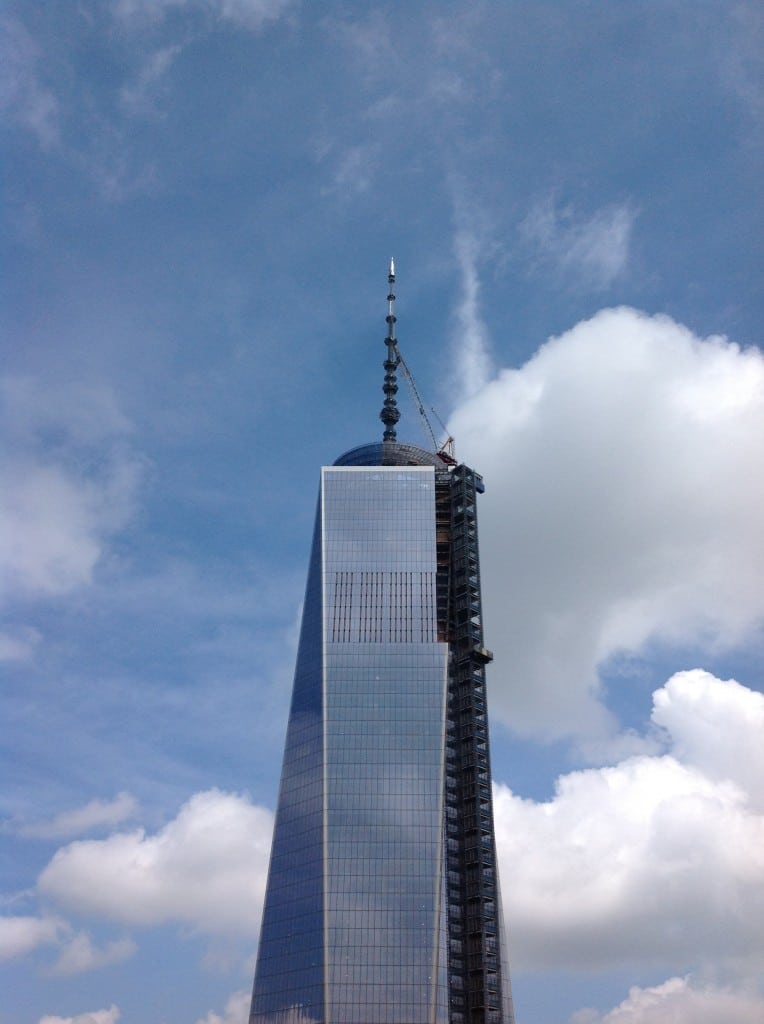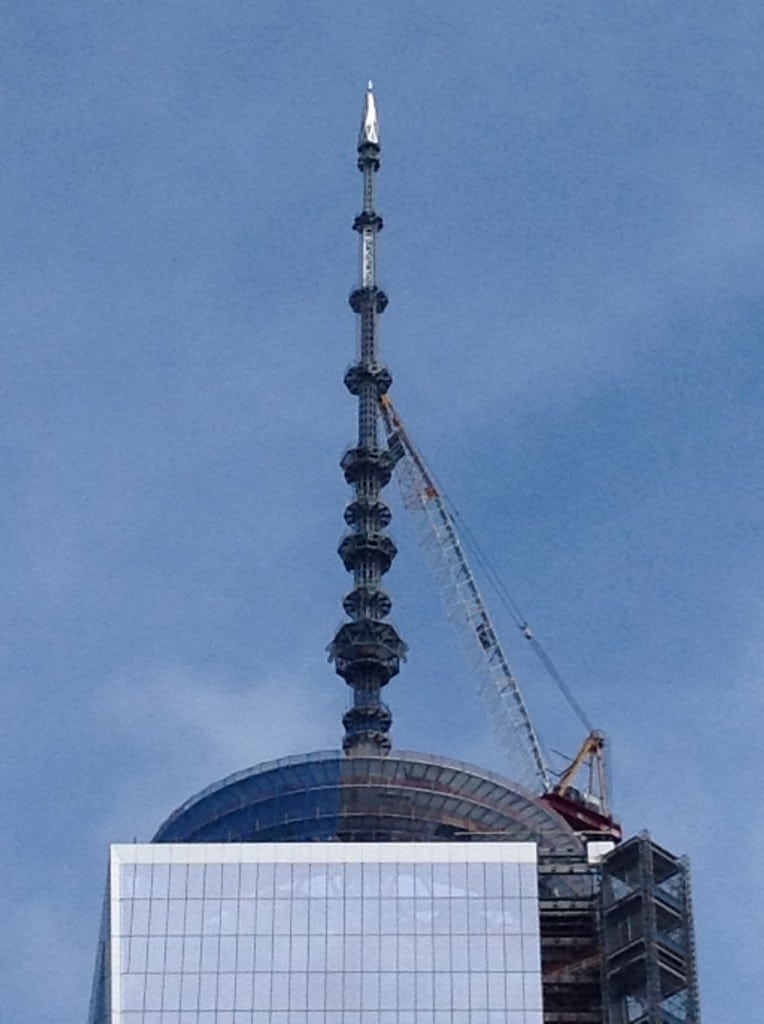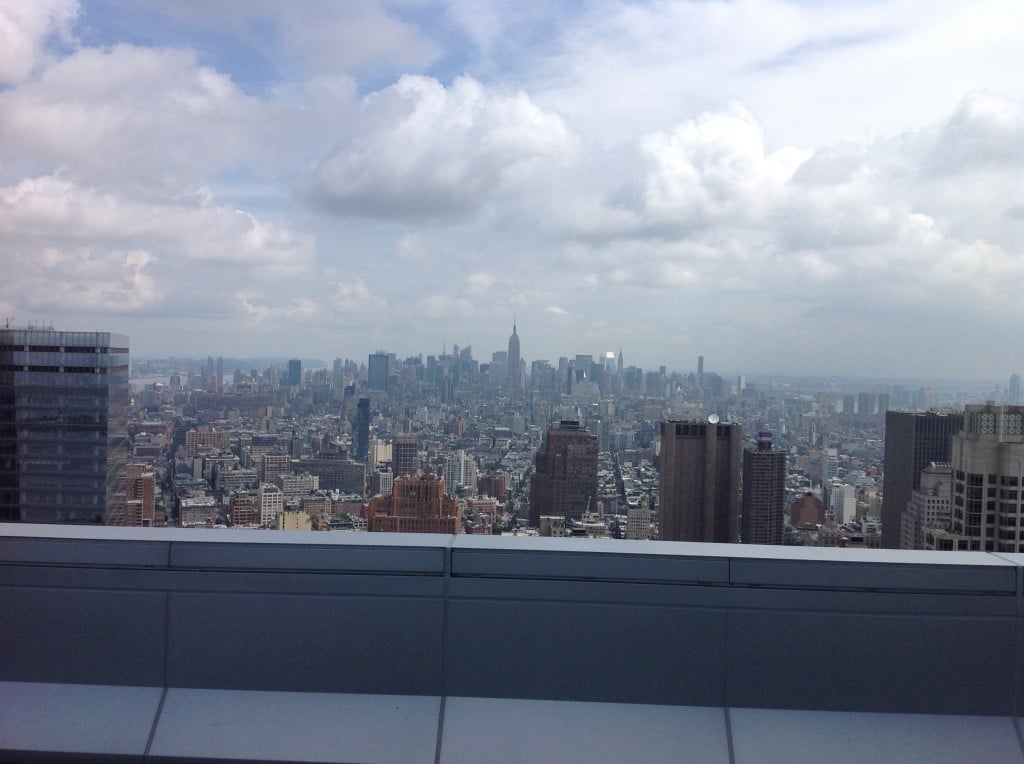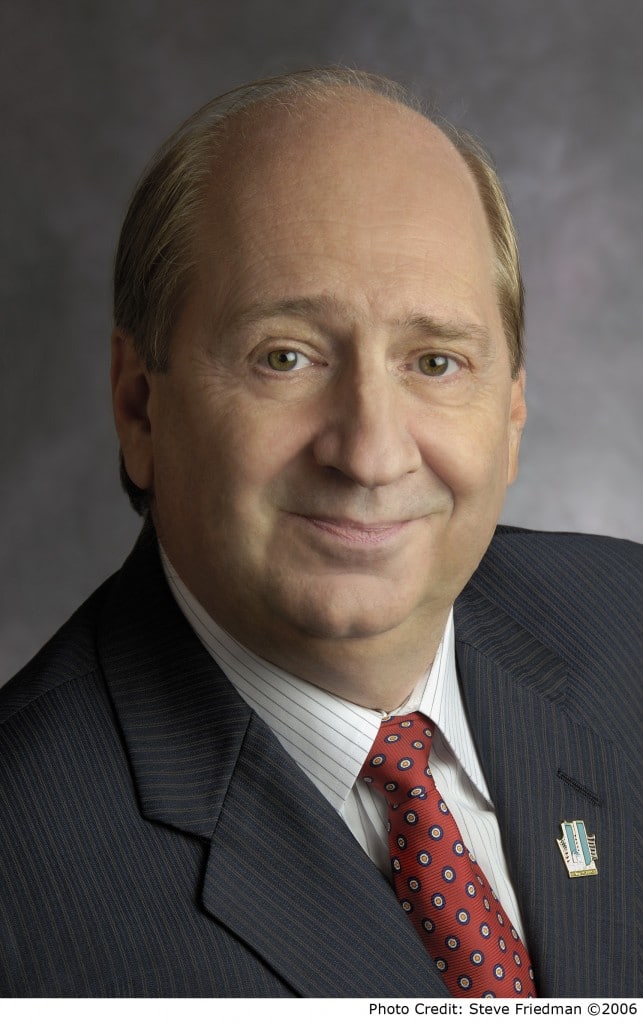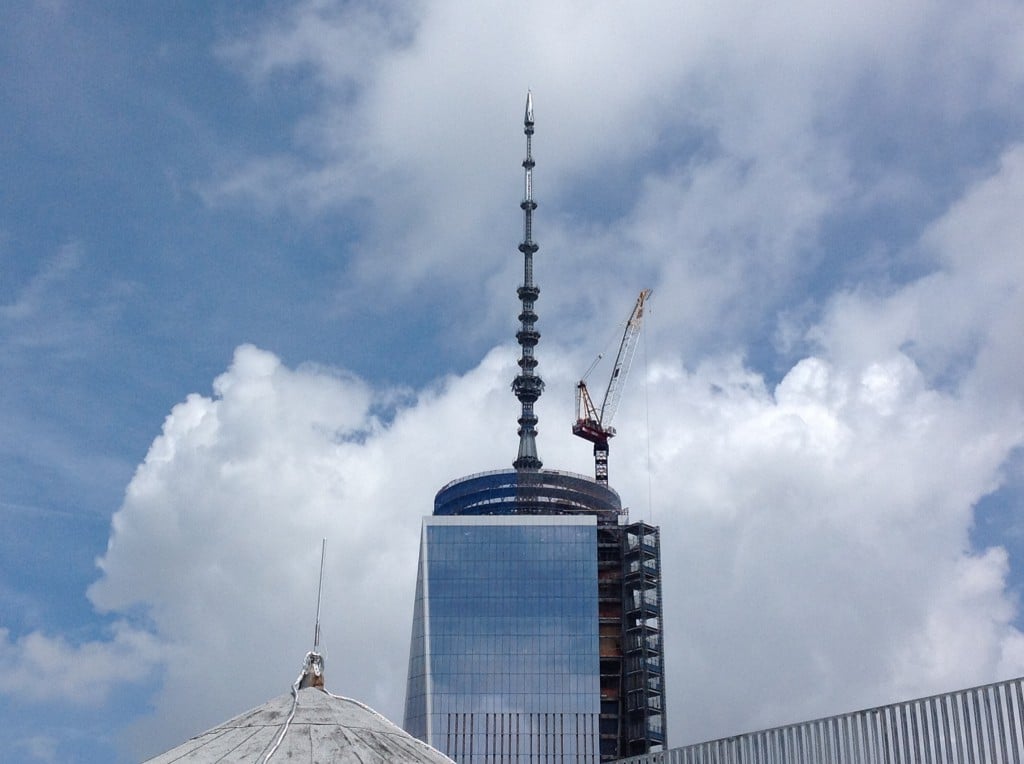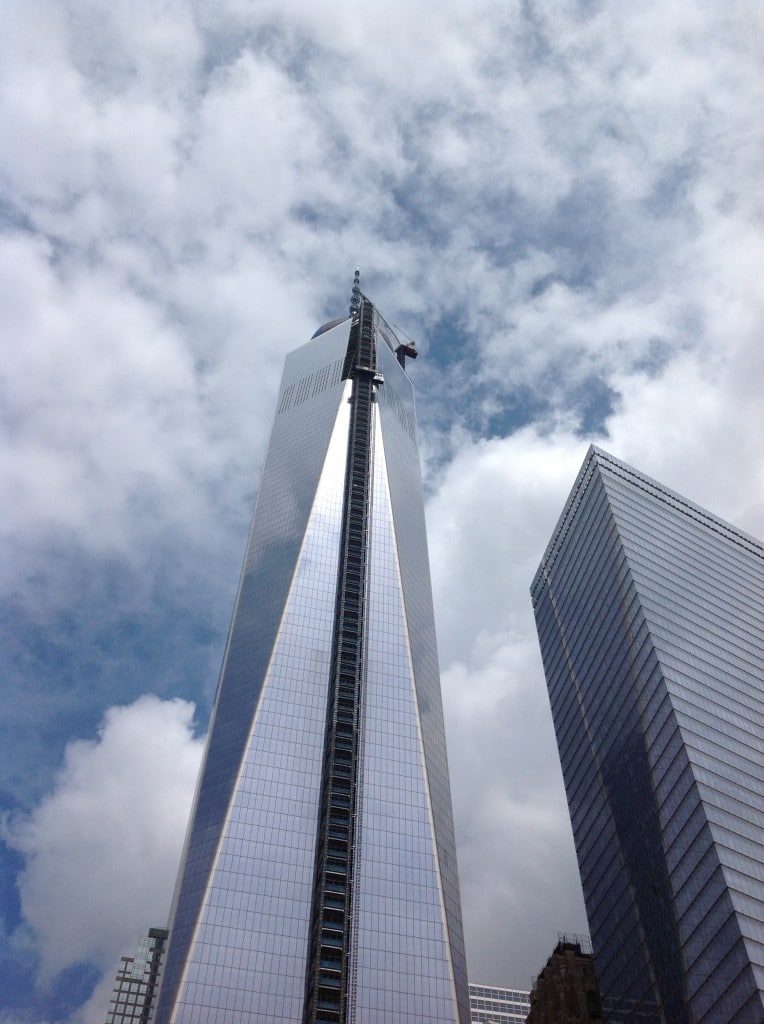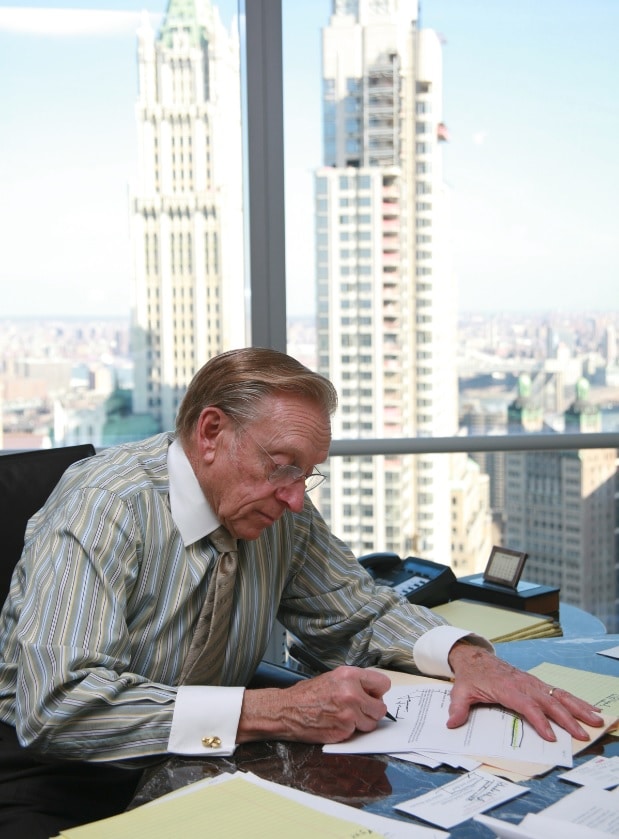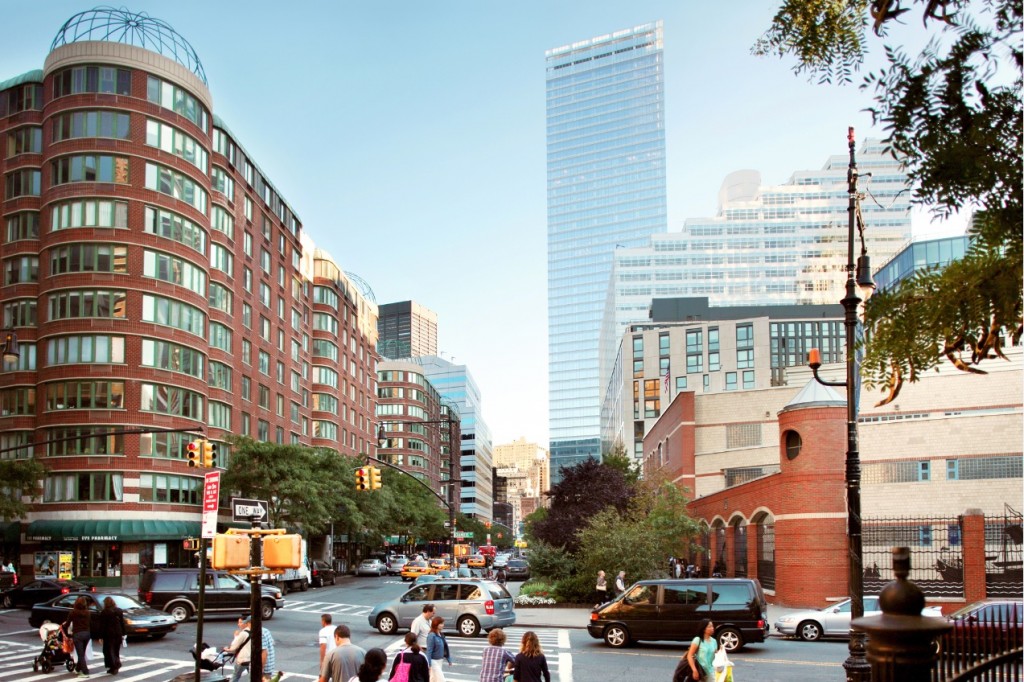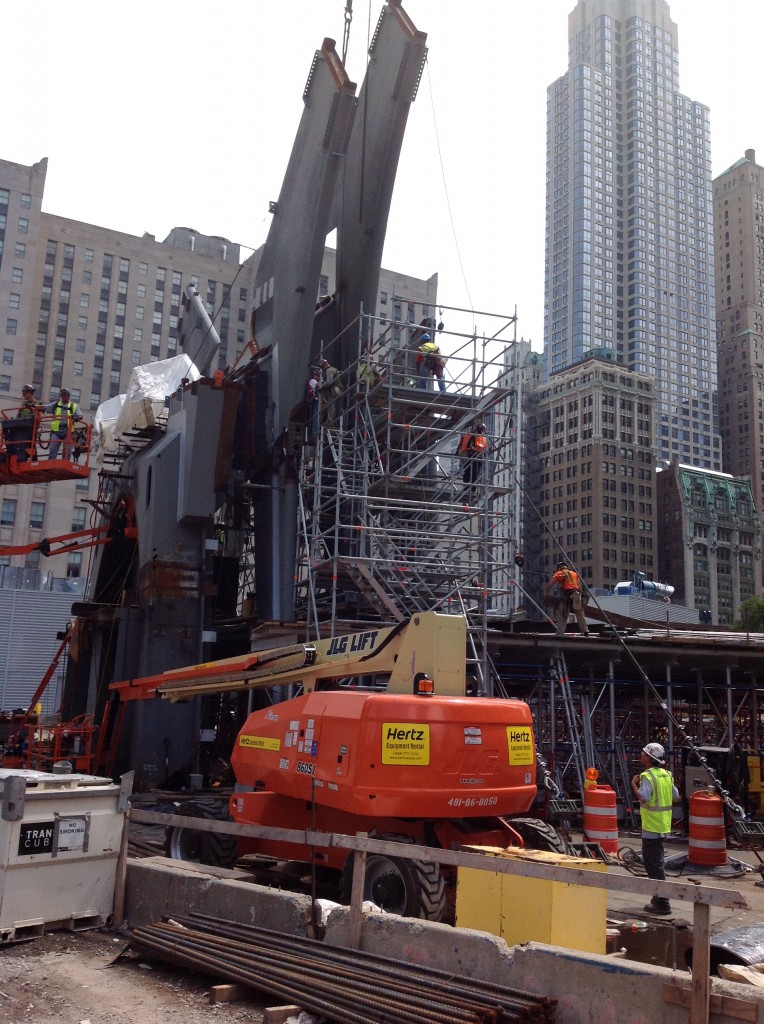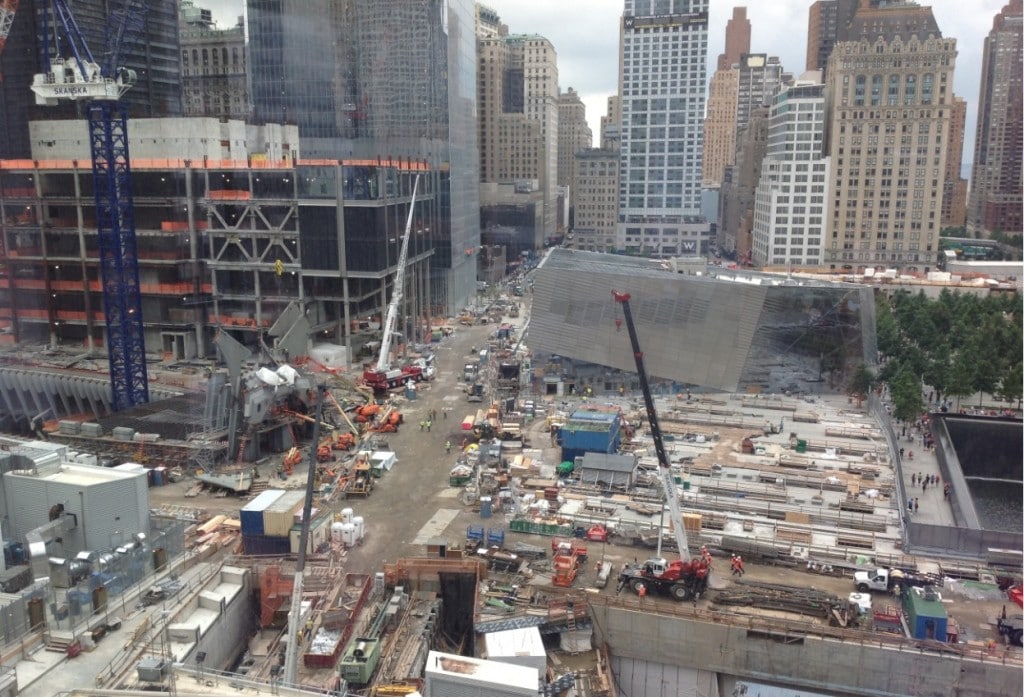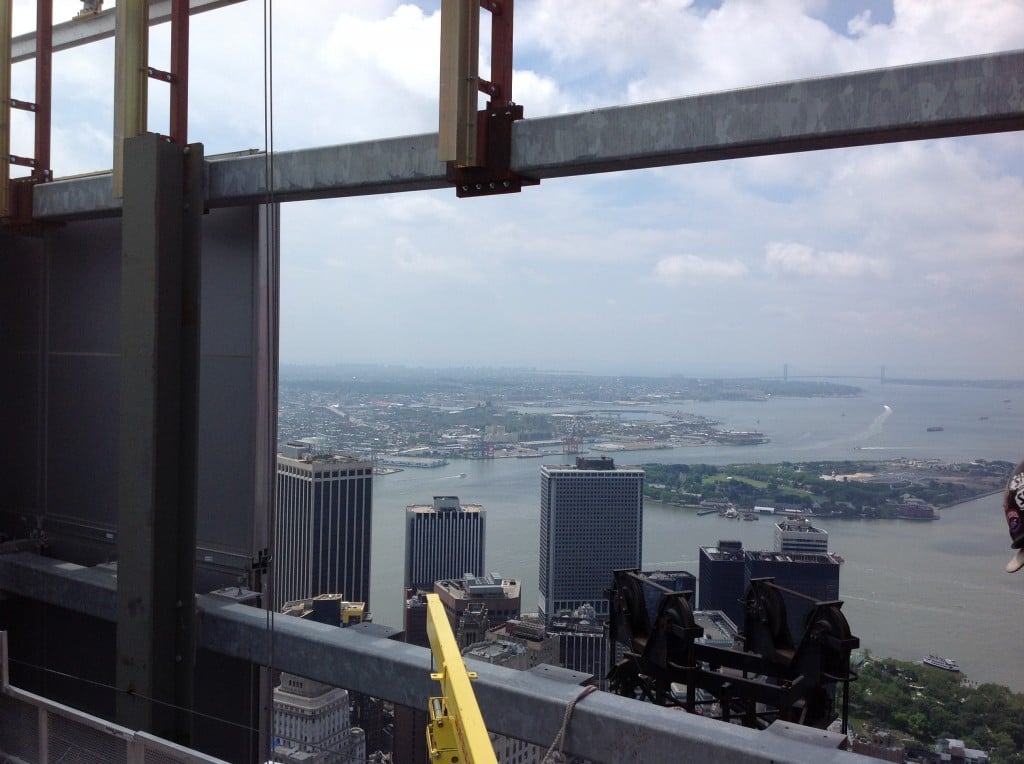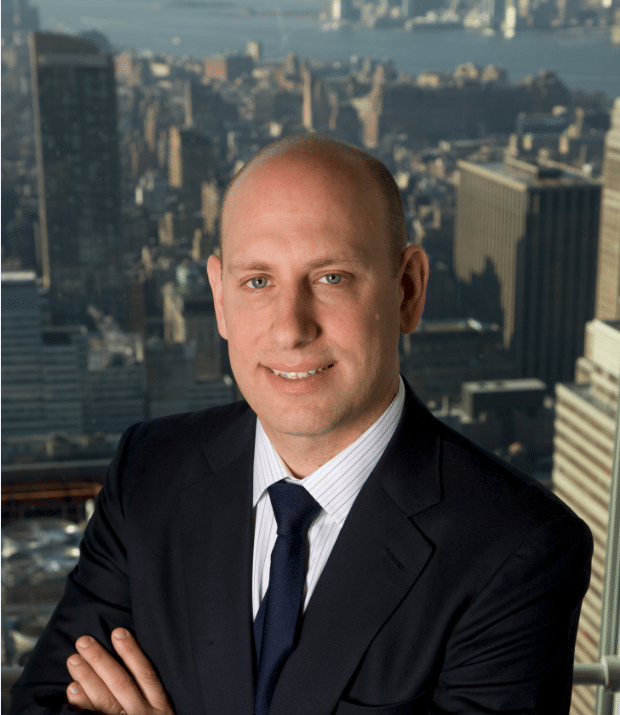Photo Credit: Carl Marcucci
It has been 12 years since the 9/11 terror attacks knocked down the twin towers in New York City—and quite a few FM and TV broadcasters with them whose antennas were housed on top. We’ve spoken on and off-record with everyone involved—from private and government entities to manufacturers and engineers–working to get the new One World Trade Center ready for broadcasters in 2015. Where do things stand? We also take a look at how much the World Trade Center Reconstruction project has revitalized lower Manhattan as a cultural, residential, business and entertainment mecca. Included is an interview with Larry Silverstein, CEO, Silverstein Properties. The company granted RBR-TVBR access to the WTC site for photographs and a tour.
One World Trade Center (1WTC) was previously dubbed Freedom Tower. It is now owned by The NY Port Authority and the broadcast facility that includes the spire at the top is managed by The Durst Organization, which has issued RFPs for the project. There is also a 12-ft torch on top of the spire. It’s a very unique lighting structure–not a traditional aviation beacon by any means.
All of the proposals have been submitted. So Durst has pricing, product detail, pattern characteristics and technical drawings on the project. The company is looking for the most flexible, future-proof system that they can possibly get. Durst also owns and manages the 4 Times Square broadcast site and can tie both of the facilities together in a very comprehensive lease package.
The RFP includes designing and building the TV antenna system; project management; an FM antenna/FM signal combiner provider and a provider for the rigid transmission lines and layout services. RBR-TVBR is unable to provide certain details in the process, as the “official” decisions have not yet been made and announced, as of 10/1/13.
Photo Credit: Carl Marcucci
“If selected to be a part of the broadcast infrastructure project at the new 1WTC facility we would be delighted to expand our long relationship with the Durst Organization and the FM radio broadcasters of New York City, and we look forward to that possible opportunity,” Martyn Gregory, VP/Shively Labs (div. Howell Laboratories), tells RBR-TVBR.
“Unquestionably the U.S. broadcasting business has had some tough challenges recently and large capital expediters, which a facility move falls under, will not come easy. However, with all of the new tall building development planned in Manhattan, having a tall premium broadcast location may become very necessary and essential to effectively serve the market. Either way Jampro-Alan Dick Broadcast will continue to be well positioned to support the broadcast business,” Alex Perchevitch, Jampro President, tells us.
Other companies well engaged in the RFP process are Radio Frequency Systems (RFS) and ERI/Tom Silliman.
New York is a bit different in that there will be several high-band VHF stations. So the big question is the breakdown of UHF versus VHF allocations. The FCC will issue an NPRM late this year which gives an outline of the allocation table. At that point, it will open up for a lot broader discussion and the broadcasters will have a pretty good idea of where they’ll end up. RFS is proposing antenna arrays that are full-band VHF (Band III) and full-band UHF, so regardless of where they end up in that spectrum, the system could accommodate them.
Midtown Manhattan taken from the 4WTC terrace
Photo Credit: Carl Marcucci
After 9/11, many dislocated NYC broadcasters moved to the Empire State Building (some were there previously as well). The 385 foot broadcast antenna at 4 Times Square was constructed in 2003 and tops the building out at 1,118 feet. The new tower was allowed for the displaced World Trade Center broadcasters to find a new home after 9/11. The tower is home to 12 FM and seven TV stations. Other area broadcasters moved temporarily and/or permanently to the Palisades, West Orange and Armstrong Towers across the Hudson River in New Jersey.
Numerous NYC broadcasters are currently tied up in long-term leases, mostly at the Empire. But by the time 1WTC is ready, many of these leases will be up. The good news for broadcasters is broadcasting from 1WTC will cover the suburbs better (and reach the fringe areas much better); the bad news is it will not have the Midtown Manhattan building penetration that Empire has (because of its more central location on the island). All of the FMs at Empire are locked in at Class B coverage. If they move to 1WTC, they will have the luxury of lowering their power some 20% (while staying at Class B) at 1WTC, because of its substantially higher height. But, again, less power means less local building penetration as well.
On the TV side, so far there has been no decision one way or the other, Doug Lung, VP/Technology, NBC NBC/Telemundo stations, tells RBR-TVBR. Lung is kind of the technical liaison for a lot of the broadcasters. If it’s blessed by Doug, then it’s going to be the right thing, from what we’ve heard.
As to the other NYC TV broadcasters, one top engineer tells us that as far as he knows, know no one has made up their mind. Each site has its own advantages and disadvantages so it isn’t purely a technical, business or operational choice but a combination of the three: “Add to that the uncertainty over the FCC’s repacking of the television band, high cost of changes at either location, and possible new transmission technology at some point and you can see why you’re not finding people willing to make a call on this.”
Nonetheless, 1WTC is making it very attractive for broadcasters to locate there and may well provide more attractive lease pricing too. Broadcasters on Empire right now have no option to move, so their leases are probably top-dollar, from what we’ve heard. That’s negotiating fodder for Durst, as it moving to the new building becomes an option.
We’ve also heard no interest yet on the FM side. SBS’s WPAT-FM may be the first FM to move to 1WTC—in fact, they are the only NYC station still licensed to WTC, even after 9/11.
RBR-TVBR interviewed John Lyons, Assistant Vice President and VP/Director of Broadcast Communications and Jordan Barowitz, Director of Consumer Affairs for the Durst Organization. Lyons is in negotiations with the broadcasters and is charged with coordinating leases.
What will be the height of the antennas atop 1WTC? I know the old one at the twin towers was 1,335 feet.
Lyons: The top of the building is 1,368. Going up another 408 feet is the spire above the rooftop. The antennas will be starting at about 1,480, and going to 1,700 feet. The top of the spire is 1,776 feet. [not an accident]
So far, what radio and TV stations are contracted to move to 1WTC?
Lyons: The simple answer to that is none. We are talking to everybody. But nobody has stepped forward at this point. It is down the road before the building is actually totally finished, and there are antennas up there. That goes back to the repacking of the television band—that’s what the hold-up is–to make a commitment to finalize the antennas and everything that goes along with getting broadcasters up there on the TV side. The FCC has an auction of some of the spectrum. It is tentatively scheduled for June, 2014. They want to clear 10 channels in the band nationwide to be able to offer it to broadband to sell. So, they are repacking some of the channels. It will be an upper UHF and a lower UHF with a separation of the band in the middle. But in some markets, some of those UHF stations may move to the VHF channels. Until the auction actually takes place middle of next year, or a year out from right now, we don’t know exactly which channels these stations are going to a) be voluntarily move to or b) be forced to move to, to know what antennas I need to actually put up there.
Was is the scope of what you are in charge of, regarding this antenna site?
Lyons: That’s all on us. Durst Broadcasting LLC has contracted to be the rooftop manager for all of the broadcast and telecommunications that could be up there. Everything is on us to pick the manufacturers, to run the job, to get everything done, do the license agreements with the broadcasters, and all of that.
So it sounds like it is pretty turn-key.
Lyons: Yes. We are trying to do it as we have done at 4 Times Square–make everything plug and play. We are supplying the HVAC and the electric. The stations just need to have contractors connect their terminal gear—the transmitters, combiners, etc. But, everything else we are supplying.
Who are some of the people that you can name that you are in discussions with? ABC, NBC, Fox, Clear Channel, Cumulus?
Lyons: All of the above. TV and FM radio, not AM radio. We are also talking to Hispanic Broadcasting, the City of New York, WNYC/New York Public Radio, Newark Public Radio, Columbia University, Emmis, NYU, Fordham, more. We are reaching out and talking with everybody.
View of 1WTC spire taken from 4WTC rooftop
Photo Credit: Carl Marcucci
What are some of the issues that are going back and forth between you?
Lyons: Economics is definitely one of the things, and coverage. They all want to make sure they keep the coverage and the audience population numbers that they presently have. Moving downtown a little bit, that they are not going to lose what is further north when they move. They want to keep the same population that they currently have.
Is it a given that because the spire is so high up that they will have to reduce their power a bit?
Lyons: There would be a power reduction, because by the FCC rules, if you keep the same class of station operation, it is a combination of height and power. It would be a slight power reduction from what they presently have at Empire. It would obviously be a decrease from what they have at 4 Times Square, because that is a lower building. That would need to be discussed case-by-case. But the station, as the licensee of the FCC, they would have to discuss with the Commission what they could to do make sure that they have the same coverage they presently have.
Are any limits as to how many FM’s and TV’s can be up there?
Lyons: We can house every station in New York to DMA. All the TV’s. There are just a few that we are hearing about that use low power that are trying to come in under the auction parameters. All of the FMs in the market, I believe there are 21 of them. There are 11 TV’s and 21FM’s, we can carry all of them.
What are some advantages that you have been able to relay to broadcasters about moving to 1WTC?
Lyons: Modern facility; state-of-the-art plant; the fact that we are handling all of the stuff that they would be handling themselves, like HVAC and electric. We are putting the generators in; we are doing all the stuff that is necessary for them to just plug and play.
What other communications would to be transmitting off of that?
Lyons: There will be three communication rings up there that will be housing point-to point -microwave, electronic news gathering antennas, remote pick up antennas, cameras–the beauty shots–for television (fixed and steerable). The ancillary services will be handled on the three communication rings just on the top of the building.
What will the antenna placement be on the spire?
Lyons: If you look at a picture of 4 Times Square top, you can probably get a pretty good idea. Those are Dielectric antennas, the radomed antennas up there on the middle of tower. Essentially it will be one or two UHF antennas, if that’s what the repack dictates. Maybe one UHF and two VHF antennas, if that’s what the repack dictates, and an FM antenna. It would be basically, four antennas and whatever you need from 1,480 to 1,700 feet. It wouldn’t be full. There would be room for some other standalone antennas, if somebody had a particular directional pattern that they needed to maintain–as opposed to being on one of the master antennas in an omnidirectional format.
Photo Credit: Carl Marcucci
What about the install folks?
Lyons: In New York City, it is an electrical job. Antennas and transmission line come under Local 3’s jurisdiction. So we would probably have a composite crew of Local 3 Electricians and Local 4 Iron Workers putting it up. That would be obviously bid at the appropriate time.
How is the Durst Organization contracted with the New York Port Authority to handle the broadcast portion of 1WTC?
Barwowitz: The Port Authority owns the building. We have a $100 million stake in the building. We are serving as the development advisor, operator and leasing agent. We have a separate agreement for the broadcast. We lease the rights to manage and run the broadcast operation for the Port as a lease. They are the landlord and we are the tenant on the broadcast lease.
What floors will the transmitting equipment be housed?
Lyons: It is presently scheduled to be on the 89th mezzanine. The entire mezzanine will be broadcast. Somewhere around 32,000 square feet.
On the revitalization of Lower Manhattan
It took years, but The World Trade Center district (within NYC’s Financial District) has already been revitalized—even without all of the buildings being completed yet. With everything we’ve been hearing about it and what we saw, a whole new world has been created down there in the last year or two. A lot of companies are locating down there–including restaurants, media companies, entertainment companies, residences and more.
As far as 1WTC, the anchor tenant is Conde Nast. They have just shy of 1.2 million square feet. The Vantone China Center (real estate) has 200,000 square feet. The General Services Administration has just shy of 300,000 square feet. The building is 55% leased. In addition to those office leases, Legends Hospitality is leasing the top three floors, which is the observation deck. Conde Nast expects to at the beginning of 2015, as does Legends. The building will be open at the beginning of 2015.
Downtown is now a 24/7 mixed-use community. It is the fastest-growing residential neighborhood in NYC. Even years after 9/11, downtown was “slightly desolate.” That’s no longer the case. Lower Manhattan is now vibrant and exciting. It has a blooming cultural community with a lot of terrific restaurants and tremendous growth in residential development. The residential boom happened after many realized just what downtown had to offer with its access to public transportation and proximity to parks, open space and waterfront. That was a major catalyst.
Here’s our interview with Larry Silverstein:
Photo Credit: Joe Woolhead
What new businesses and headquarters are moving in down there?
We built, financed and opened 7 WTC in May 2006, as the first LEED-certified office building in New York – achieving the Gold standard. It boasts an array of innovative sustainable design and energy efficient features, which ultimately make it a healthy and productive place to work.
The building leased up beautifully to a wide range of world-class companies, including creative, advertising and publishing companies such as BMI, and not-for-profit organizations and financial services firms such as Moody’s and Ameriprise. Many of these companies moved to 7 WTC because it was a green building. These companies are proof that New York could and would come back stronger than before. They believed – like I do – that that Downtown had enormous potential both as a residential neighborhood and as a business district – and that it could and would become THE model 24/7 live-work mixed-use community.
7 WTC in the background
How is the cultural, social, entertainment and dining scene changing?
Over the past decade, Lower Manhattan has undergone a remarkable transformation. The number of people living Downtown has doubled to 60,000. The area around the WTC has become a one-of-a-kind model of sustainable urban development. Downtown boasts perhaps the best mass transit connections of any area in the City – and maybe the entire country. And more than 25% of Downtown residents walk to work – a figure much higher than any other area in the United States. And it has by far New York’s densest concentration of green buildings.
Downtown is home to some of the best schools in the city, including Stuyvesant high school and PS 234. The neighborhood features some of the best restaurants and bars and nightlife, as well as a unique waterfront with magnificent parks and recreational facilities. Downtown attracts almost six million visitors a year and is fast becoming one of the best places in the country to visit, to work and to live.
When did this renaissance begin? Why?
After 9/11, it took some time to develop a plan that reconciled all the different interests and goals New Yorkers had for a rebuilt Trade Center site, beginning with an appropriate memorial that honors the memory of the almost 3,000 people who lost their lives here on 9/11.
Fortunately, Daniel Libeskind’s Master Plan for the WTC reconciled everybody’s goals in a very meaningful way. It turned half of the site into public space and re-introduced Manhattan’s historic street grid through the site, connecting the new World Trade Center seamlessly to the surrounding neighborhoods. It added several new elements like an iconic transit gateway to lower Manhattan, a performing arts center, and a livelier retail streetscape. It also ensured that we could rebuild the core of Downtown’s office district, which had been destroyed by the terrorists on 9/11.
Ongoing construction at WTC site
Photo Credit: Carl Marcucci
Why do you think WTC is becoming so popular now?
Today, we are clearly at a pivotal moment in Downtown Manhattan’s reemergence. With the impressive construction progress all across the WTC site; the opening of the Goldman Sachs headquarters; the success of 7 World Trade Center; and with Condé Nast’s decision to move its headquarters to One World Trade Center, the world has really begun to take notice of what is happening Downtown.
The Memorial opened on schedule on the 10th anniversary and has already welcomed over six million visitors from all over the world. For the first time since 9/11, people can visit the World Trade Center site.
Today, every part of the new World Trade Center is under construction and on its way to completion. More than 3,000 workers are shaping millions of tons of concrete, steel and glass into iconic buildings that have already reclaimed New York’s skyline.
The foundation work on 2 WTC – designed by Norman Foster – is complete and that building is now above sidewalk level. 3 WTC – designed by Richard Rogers – has reached eight floors, and we hope to finish and open it by 2016. Work on the transit hub is also well underway and Santagio Calatrava’s spectacular arches should be visible in the coming months.
At 104 stories, One WTC is now the tallest building in Manhattan. Our building, 4 WTC, topped out at 72 floors last June and will be the first to open on the 16-acre site later this year.
A view atop 4WTC–the roof was not finished yet.
Photo Credit: Carl Marcucci
Is there a feeling of closure with all of this taking shape among New Yorkers?
I sincerely hope that our work at the World Trade Center will be viewed as a fitting tribute to those who died on 9/11, and also as a tribute to all New Yorkers, who have been through so much in the last twelve years.
I believe many New Yorkers have come to recognize that Downtown has a bright future – in part because great companies want to be in high tech, green buildings – but also because they want to be right next to the best mass transit and dynamic residential neighborhoods filled with young, creative talent.
What might Lower Manhattan end up like after the entire WTC project is complete?
In Lower Manhattan we are reinventing what it means to be a city for the 21st Century.
Here’s what Jordan Barowitz had to say:
As far as One WTC, what new business and headquarters are in there now, and/or contracted to be in there, or are interested?
The anchor tenant is Conde Nast. They have just shy of 1.2 million square feet. The Vantone China Center (real estate) has 200,000 square feet. The General Services Administration has just shy of 300,000 square feet. The building is 55% leased.
Do you know the estimated time that the building will be open all the way up to the top, where all the space is basically open to the public?
In addition to those office leases, Legends Hospitality is leasing the top three floors, which is the observation deck. Conde Nast expects to at the beginning of 2015, as does Legends. The building will be open at the beginning of 2015.
Jordan Barowitz
With some of the companies locating at the World Trade Center Complex, how are things changing?
The biggest change from prior to 2001, is that downtown is now a 24/7 mixed-use community. It is the fastest-growing residential neighborhood in New York City. That has really exploded in the previous 10 years. Downtown for a while, at night, it became slightly desolate. That is no longer the case. Lower Manhattan is vibrant and exciting. It has a blooming cultural community with a lot of terrific restaurants and just tremendous growth in residential development.
The residential boom in Lower Manhattan happened in 2002-2003. New York is an ever-expanding, ever-changing city. I think people realized just what downtown had to offer with its access to public transportation and proximity to parks, open space and waterfront. That really was the catalyst for this residential growth.
What kind of closure do you see happening down there amongst New Yorkers now that these buildings are going up?
I think there is a tremendous sense of pride. While it is not been a perfectly smooth road in the rebuilding process, One World Trade Center is back on the skyline, bigger and better than ever; the Memorial has now been open for close to two years. The site itself is taking shape architecturally and New Yorkers are soon to be able to go reclaim the World Trade Center site as part of New York City.
What might it all look like when you travel to Lower Manhattan and you walk through the WTC area?
I think you will find an architecturally significant, bustling, 24/7 community where people live and work and recreate, all within close proximity of each other. It’s what makes Lower Manhattan and the Trade Center site so compelling as an office address, besides the stature and quality of the building, is its proximity to transportation and also the tower. There has been a tremendous growth in the talent that now lives in Brooklyn and northern New Jersey. The Trade Center’s transportation network links those communities to the site and makes it a really desirable office address.



